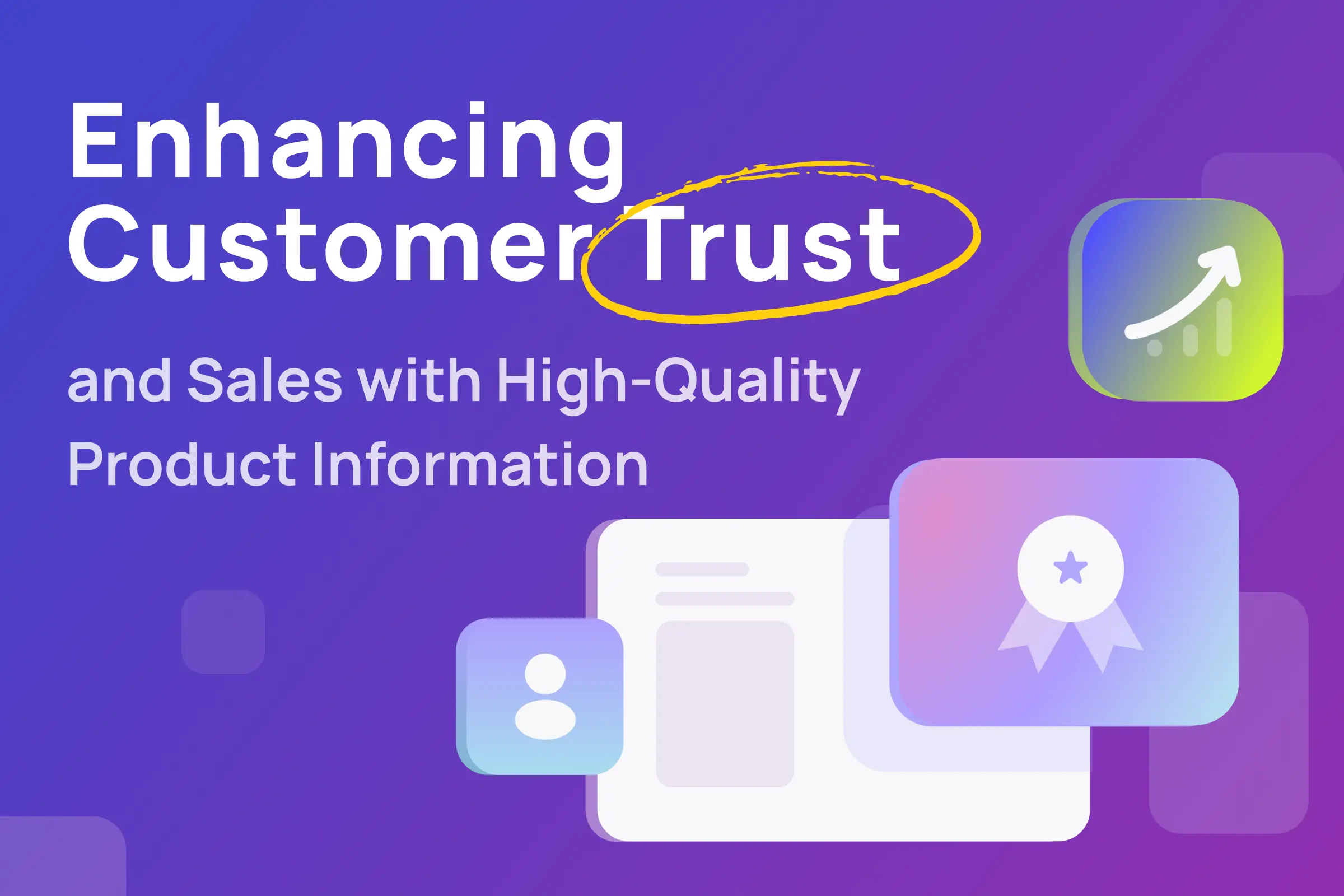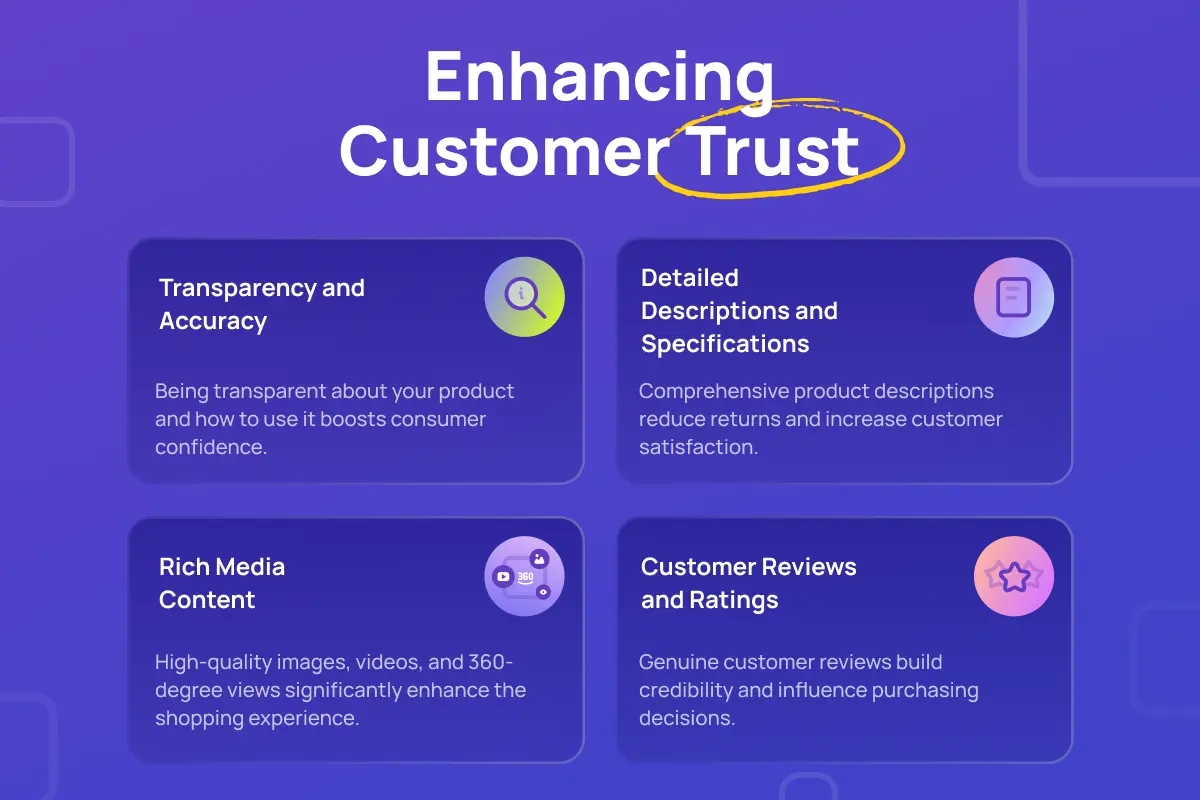
Enhancing Customer Trust and Sales with High-Quality Product Information



Product information goes beyond just labels on a can, although it does include labels! All the data that your company holds for all of its products (that’s product information). From ingredients and sales labels to receipts for parts, and even assembly and cooking instructions, every bit of information, however small, is considered product information.
With so much raw data, managing product information can quickly become a major task. That’s especially true for companies that handle large numbers of products or who sell across multiple sales channels.
Product information management, or PIM, isn’t just about tracking raw data. When used correctly, a good PIM equips your company with everything it needs to deliver high-quality products to the right customers at the right time. And from the customer's perspective, high-quality product data provides all the necessary details someone needs to make an informed purchase. This includes product descriptions, specifications, images, pricing, reviews, and more.
Your company benefits from superior product information in two significant ways:
Customer trust increases when consumers know that the information they’re getting is accurate, detailed, and up-to-date. They can rely on the information presented and feel confident in their purchase decisions. In turn, high-quality product data aids decision-making. Armed with accurate info, customers can compare products easily, understand features better, and assess a product’s suitability for their needs.
Investing in high-quality product data directly impacts sales and customer retention. Book a demo of Trustana's product suite to see how we can help you achieve excellence in product data management and boost your business growth.
High-quality product information is a cornerstone of building customer trust and driving sales. Here’s how:

Customers appreciate accurate information. Being transparent about your product and how to use it boosts consumer confidence. A PIM reduces the chances of incorrect information damaging your brand.
Providing comprehensive product descriptions and specifications helps customers understand exactly what they’re getting, reducing returns and increasing satisfaction.
High-quality images, videos, and 360-degree views significantly enhance the shopping experience.
Displaying genuine customer reviews and ratings builds credibility. Potential buyers trust peer reviews, and positive feedback can influence purchasing decisions.
Trustana's Product Information Management (PIM) system offers a comprehensive suite of tools designed to streamline the management of product data across multiple platforms. Here are some key features:
Trustana’s PIM provides a single source of truth for all product information, thereby ensuring consistency and accuracy across all sales channels and platforms.
Publishing product data from one source simplifies the process and unifies product data across various platforms. That includes eCommerce sites and marketplaces.
Your business can define custom attributes specific to your products as needed, enabling more efficient product categorization and filtering.
Trustana's advanced product taxonomy feature helps organize products into unique categories and subcategories. This makes it easier for you to find and manage your projects internally, and for customers to find an exact match for what they need.
Trustana is the first to offer a fully flexible AI-powered data enrichment solution, allowing you to turn scarce data into rich data, ready for your e-commerce store.
Leveraging these features, businesses can significantly reduce the time and effort required to manage product data, leading to improved operational efficiency and better customer experiences.
Given the power of an effective PIM to enhance trust and boost sales, here are some strategies to maximize the impact of your PIM:
Deploy Trustana to ensure that all product information is consistent and updated across all sales channels. Manage all product data centrally with your core team, so any updates are only a click away. With Trustana, you can also track when changes were last made, so you’ll know which products to update next.
Use Trustana’s AI functionality to enrich product listings with detailed descriptions, high-quality images, and videos. This is crucial in digital-first sectors like e-commerce, where dynamic information makes product listings more appealing and informative.
Leverage Trustana’s AI-powered content generator to create SEO-optimized product descriptions. This increases the visibility of your products on search engines, driving more organic traffic to your site.
These strategies are critical to getting the most out of your PIM. Use Trustana’s full capabilities to turn product information into actions that directly impact your bottom line.
Building trust and boosting sales is more than an admirable goal; with Trustana, it can be a reality for your company just like it has been for others.
Here’s how enhanced product data drove success for other business that have adopted Trustana's solutions:
Shark Ninja: Deployed Trustana’s PIM to complete product attribute details on various product listings for their Amazon store. Trustana’s AI-powered content generator completed the job quickly and efficiently, leading to a significant increase in conversion rates.
Primea: Saved 200 days of work while achieving a 5x faster time-to-market, thanks to Trustana’s end-to-end automation of new product onboarding into market-ready listings.
Trustana’s automation features allowed both companies to streamline data collection and input, tasks that were time-consuming and detracted from valuable human resources. That automation enabled both companies to get to market faster, to get more products in front of potential customers with Trustana.
Improved product information also has significant SEO advantages. Trustana's content generator ensures that product data is optimized for search engines, helping to increase organic traffic and drive more sales.
To learn more about how Trustana can enhance your product data management and integrate with your current systems, book a demo today and experience the difference firsthand.
Accurate and detailed product data ensures that customers have all the necessary information to make confident purchasing decisions. When product descriptions, images, and specifications are clear and accurate, it reduces customer uncertainty, leading to higher trust in your brand. Customers are more likely to buy from a retailer who consistently provides complete and reliable product data.
Incomplete or incorrect product data can confuse customers, leading to dissatisfaction and cart abandonment. If key product details are missing or inconsistent across channels, customers are less likely to trust your brand. This can result in lost sales and lower customer retention rates.
Consistent product data across all sales channels, whether in-store, online, or on marketplaces, builds a cohesive customer experience. When product details are uniform, customers feel more confident in their purchase decisions. This consistency improves brand credibility, increases conversion rates, and drives repeat business.
Yes, detailed product data enhances search engine optimization (SEO), making it easier for potential customers to find your products. When your product data is enriched with relevant keywords, specifications, and attributes, search engines can better index your products, leading to improved visibility in search results and increased traffic.
Customers are more likely to return to brands that provide detailed and reliable product information. When product data is accurate, complete, and aligned with customer expectations, it fosters a sense of trust. This trust translates into repeat purchases and long-term customer loyalty.
Absolutely. Well-enriched product data ensures that every detail—from descriptions to images—is optimized for conversion. It answers customers' questions, provides reassurance, and helps them make quicker purchase decisions. The more comprehensive and persuasive your product data, the higher the likelihood of converting visitors into buyers.
A detailed and accurate product page helps customers easily find what they’re looking for, understand the benefits of the product, and assess whether it meets their needs. This results in a smoother, faster, and more confident shopping experience, increasing the chances of a completed purchase.
Using generic product data from manufacturers often leads to a lack of differentiation, making it harder to stand out in competitive markets. Generic descriptions can also be vague, causing customers to lack confidence in their purchase. Unique, enriched product content creates a more compelling and trustworthy presentation, which boosts sales and conversion.
When customers have all the information they need before purchasing, including accurate images and detailed descriptions, they’re less likely to be dissatisfied with their purchase. This reduces the number of returns and exchanges, saving time and money while increasing customer satisfaction.
High-quality product data enables effective cross-selling and upselling by showcasing related or complementary items. By providing detailed information about other products, you help customers discover additional items that fit their needs, ultimately increasing average order value (AOV) and total sales.